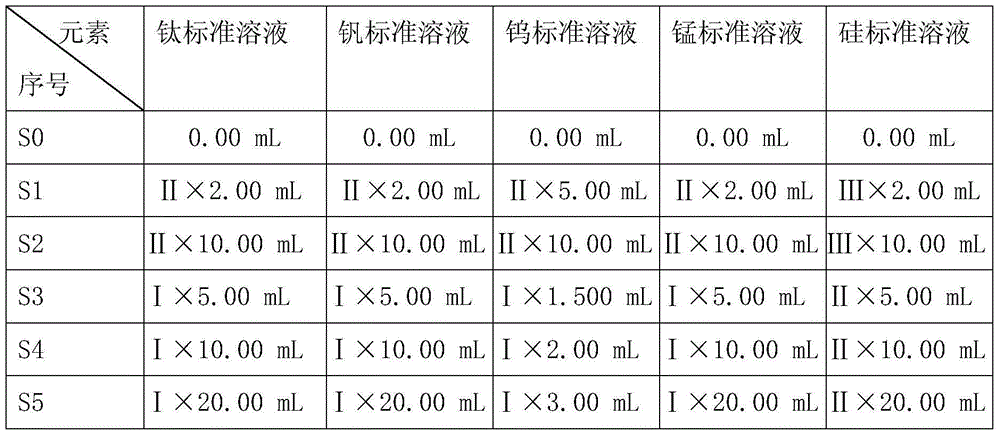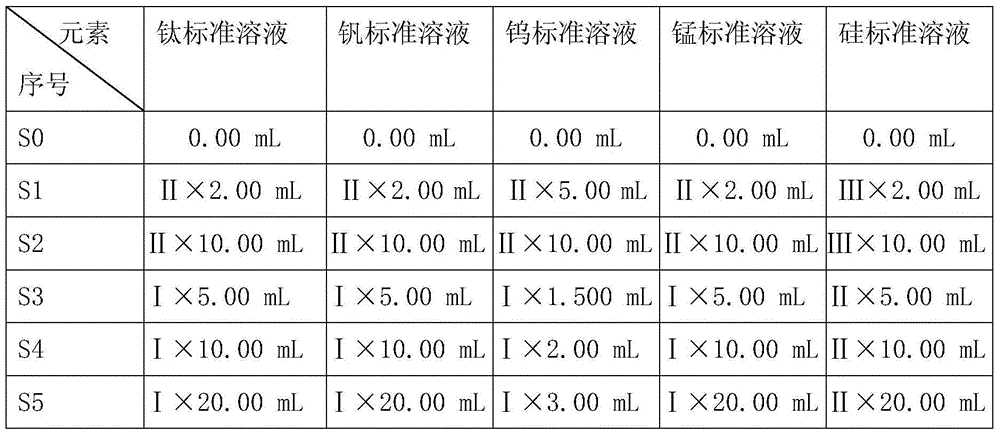Analysis method for determining titanium, vanadium, tungsten, manganese and silicon in K25 chromium-base high temperature alloy
A technology of superalloy, titanium vanadium, applied in the field of alloy constant element analysis, can solve the problems of incomplete dissolution, long analysis period, long time for dissolving samples, etc.
- Summary
- Abstract
- Description
- Claims
- Application Information
AI Technical Summary
Problems solved by technology
Method used
Image
Examples
Embodiment 1
[0072] To measure the content of titanium, vanadium, tungsten, manganese and silicon in K25 chromium-based superalloy, an inductively coupled plasma emission spectrometer is used. The working conditions and analysis lines of the instrument are as follows: high frequency frequency: 40.68MHz; incident power: 0.95~1.1Kw ;Reflected power: <15W; Cooling air flow: 12~20L / min; Sheath air flow: 0.1~0.6L / min; Sample lift: 1.0~1.5ml / min; Integration time: 1~10s; : Titanium 334.941nm; Vanadium 292.402nm; Tungsten 207.911nm; Manganese 257.610nm; Silicon 288.158nm or 251.611nm;
[0073] (1) The reagents used in the determination process are as follows:
[0074] (1.1) Hydrochloric acid, ρ1.19g / mL; superior grade;
[0075] (1.2) Nitric acid, ρ1.42g / mL; superior grade;
[0076] (1.3) Sulfuric acid, ρ1.84g / mL; superior grade;
[0077] (1.4) Hydrofluoric acid, ρ1.15g / mL, superior grade;
[0078] (1.5) sulfuric acid, 1+1;
[0079] (1.6) Nitric acid, 1+1;
Embodiment 2
[0120] To measure the content of titanium, vanadium, tungsten, manganese and silicon in K25 chromium-based superalloy, an inductively coupled plasma emission spectrometer is used. The working conditions and analysis lines of the instrument are as follows: high frequency frequency: 40.68MHz; incident power: 0.95~1.1Kw ;Reflected power: <15W; Cooling air flow: 12~20L / min; Sheath air flow: 0.1~0.6L / min; Sample lift: 1.0~1.5ml / min; Integration time: 1~10s; : Titanium 334.941nm; Vanadium 292.402nm; Tungsten 207.911nm; Manganese 257.610nm; Silicon 288.158nm or 251.611nm;
[0121] (1) The reagents used in the determination process are as follows:
[0122] (1.1) Hydrochloric acid, ρ1.19g / mL; superior grade;
[0123] (1.2) Nitric acid, ρ1.42g / mL; superior grade;
[0124] (1.3) Sulfuric acid, ρ1.84g / mL; superior grade;
[0125] (1.4) Hydrofluoric acid, ρ1.15g / mL, superior grade;
[0126] (1.5) sulfuric acid, 1+1;
[0127] (1.6) Nitric acid, 1+1;
Embodiment 3
[0162] To measure the content of titanium, vanadium, tungsten, manganese and silicon in K25 chromium-based superalloy, an inductively coupled plasma emission spectrometer is used. The working conditions and analysis lines of the instrument are as follows: high frequency frequency: 40.68MHz; incident power: 0.95~1.1Kw ;Reflected power: <15W; Cooling air flow: 12~20L / min; Sheath air flow: 0.1~0.6L / min; Sample lift: 1.0~1.5ml / min; Integration time: 1~10s; : Titanium 334.941nm; Vanadium 292.402nm; Tungsten 207.911nm; Manganese 257.610nm; Silicon 288.158nm or 251.611nm;
[0163] (1) The reagents used in the determination process are as follows:
[0164] (1.1) Hydrochloric acid, ρ1.19g / mL; superior grade;
[0165] (1.2) Nitric acid, ρ1.42g / mL; superior grade;
[0166] (1.3) Sulfuric acid, ρ1.84g / mL; superior grade;
[0167] (1.4) Hydrofluoric acid, ρ1.15g / mL, superior grade;
[0168] (1.5) sulfuric acid, 1+1;
[0169] (1.6) Nitric acid, 1+1;
PUM
| Property | Measurement | Unit |
|---|---|---|
| Concentration | aaaaa | aaaaa |
| Concentration | aaaaa | aaaaa |
Abstract
Description
Claims
Application Information
 Login to View More
Login to View More - R&D
- Intellectual Property
- Life Sciences
- Materials
- Tech Scout
- Unparalleled Data Quality
- Higher Quality Content
- 60% Fewer Hallucinations
Browse by: Latest US Patents, China's latest patents, Technical Efficacy Thesaurus, Application Domain, Technology Topic, Popular Technical Reports.
© 2025 PatSnap. All rights reserved.Legal|Privacy policy|Modern Slavery Act Transparency Statement|Sitemap|About US| Contact US: help@patsnap.com



